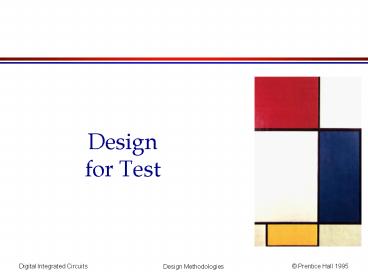Design for Test - PowerPoint PPT Presentation
Title:
Design for Test
Description:
Validation and Test of Manufactured Circuits. Components of DFT strategy ... Goals of Design-for-Test (DFT) Make testing of manufactured part swift and. comprehensive ... – PowerPoint PPT presentation
Number of Views:28
Avg rating:3.0/5.0
Title: Design for Test
1
Designfor Test
2
Validation and Test of Manufactured Circuits
Goals of Design-for-Test (DFT)
Make testing of manufactured part swift and
comprehensive
DFT Mantra
Provide controllability and observability
Components of DFT strategy
- Provide circuitry to enable test
- Provide test patterns that guarantee reasonable
coverage
3
Test Classification
- Diagnostic test
- used in chip/board debugging
- defect localization
- go/no go or production test
- Used in chip production
- Parametric test
- x e v,i versus x e 0,1
- check parameters such as NM, Vt, tp, T
4
Design for Testability
Exhaustive test is impossible or unpractical
5
Problem Controllability/Observability
- Combinational Circuits
- controllable and observable - relatively easy to
determine test patterns - Sequential Circuits State!
- Turn into combinational circuits or use self-test
- Memory requires complex patterns
- Use self-test
6
Test Approaches
- Ad-hoc testing
- Scan-based Test
- Self-Test
- Problem is getting harder
- increasing complexity and heterogeneous
combination of modules in system-on-a-chip. - Advanced packaging and assembly techniques extend
problem to the board level
7
Generating and Validating Test-Vectors
- Automatic test-pattern generation (ATPG)
- for given fault, determine excitation vector
(called test vector) that will propagate error to
primary (observable) output - majority of available tools combinational
networks only - sequential ATPG available from academic research
- Fault simulation
- determines test coverage of proposed test-vector
set - simulates correct network in parallel with faulty
networks - Both require adequate models of faults in CMOS
integrated circuits
8
Fault Models
Most Popular - Stuck - at model
Covers almost all (other) occurring faults, such
as opens and shorts.
9
Problem with stuck-at model CMOS open fault
Sequential effect
Needs two vectors to ensure detection!
Other options use stuck-open or stuck-short
models This requires fault-simulation and
analysis at the switch or transistor level -
Very expensive!
10
Problem with stuck-at model CMOS short fault
Causes short circuit between Vdd and GND for
AC0, B1 Possible approach Supply Current
Measurement (IDDQ) but not applicable for
gigascale integration
11
Path Sensitization
Goals Determine input pattern that makes a
fault controllable (triggers the fault, and makes
its impact visible at the output nodes)
sa0
1
Fault enabling
1
1
1
1
1
0
Fault propagation
0
Techniques Used D-algorithm, Podem
12
Ad-hoc Test
Inserting multiplexer improves testability
13
Scan-based Test
14
Polarity-Hold SRL (Shift-Register Latch)
Introduced at IBM and set as company policy
15
Scan-Path Register
16
Scan-based Test Operation
17
Scan-Path Testing
Partial-Scan can be more effective for pipelined
datapaths
18
Boundary Scan (JTAG)
Board testing becomes as problematic as chip
testing
19
Self-test
Rapidly becoming more important with
increasing chip-complexity and larger modules
20
Linear-Feedback Shift Register (LFSR)
Pseudo-Random Pattern Generator
21
Signature Analysis
Counts transitions on single-bit stream ?
Compression in time
22
BILBO
23
BILBO Application
24
Memory Self-Test
Patterns Writing/Reading 0s, 1s, Walking
0s, 1s Galloping 0s, 1s































